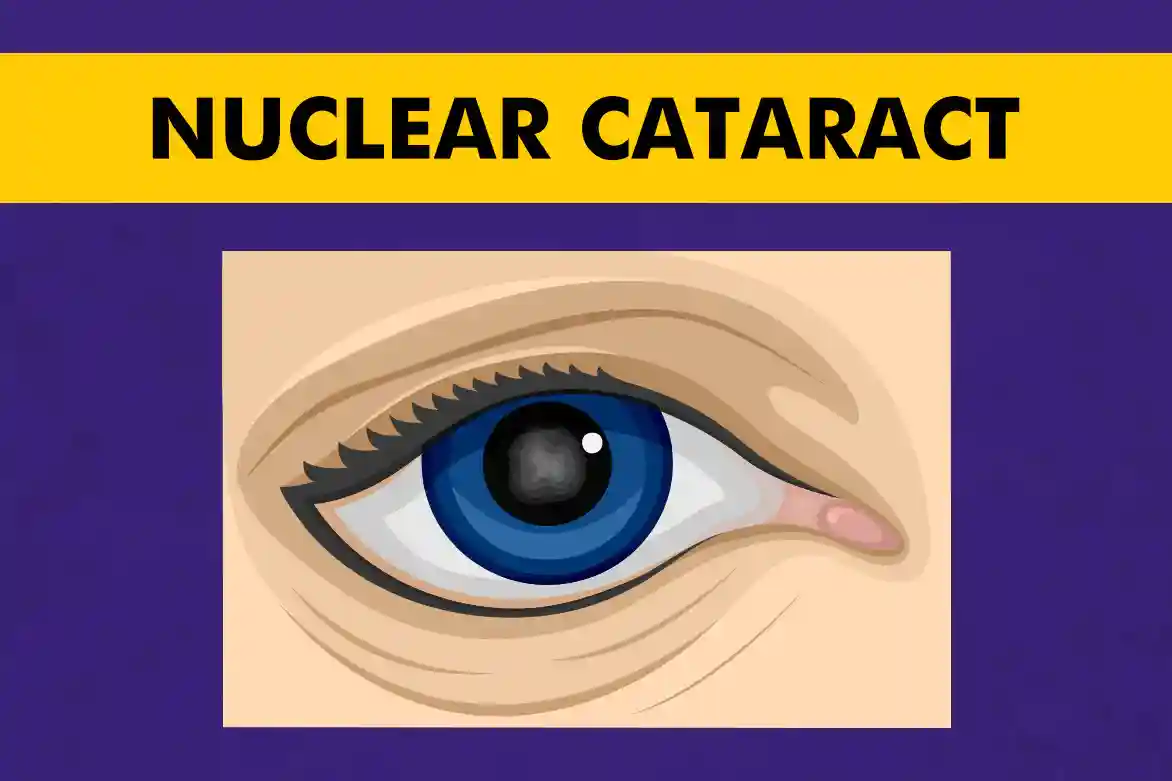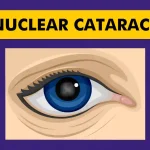A nuclear cataract is one of the most common types of cataracts, primarily affecting the central nucleus of the eye’s lens. As this condition progresses, it leads to visual impairment and difficulty in performing daily tasks. Understanding nuclear cataract symptoms can help in early detection and timely treatment. With early diagnosis and the right care plan, it’s entirely possible to maintain your independence, comfort, and clarity of vision for years to come.
Cataracts are a leading cause of vision loss worldwide, and nuclear cataracts specifically impact the clarity of central vision. The gradual nature of this condition often means that people may not notice the symptoms until their daily activities, such as reading and driving, are affected. Early intervention can help manage symptoms effectively and delay the need for surgical treatment.
If you or a loved one has been noticing changes in vision, like difficulty reading, night driving, or colours appearing dull, it may be due to a nuclear cataract, one of the most common forms of age-related cataracts. While that may sound alarming, understanding the symptoms early on can help you take confident steps toward preserving your vision.
For more information on the other ways cataracts can form, read our blog on types of cataracts.
What Is a Nuclear Cataract?
A nuclear cataract forms in the central portion (nucleus) of the eye’s lens. It develops gradually and is usually associated with ageing. Over time, the lens hardens and turns yellow or brown, affecting the ability to see clearly. This condition is often a part of the broader category of nuclear sclerosis cataract.
As the cataract progresses, the lens becomes denser, resulting in increased difficulty focusing on objects at varying distances. The hardening of the lens alters the way light passes through it, which may cause a reduction in contrast sensitivity and depth perception.
Nuclear Cataract Symptoms
Detecting nuclear cataract symptoms early is essential for effective treatment. Common symptoms include:
- Gradual decline in vision: Objects appear blurry or hazy over time, making it difficult to see fine details.
- Difficulty seeing in low light: Vision worsens, especially at night or in dimly lit environments, making activities such as driving particularly challenging.
- Increased nearsightedness: Frequent changes in prescription glasses as the lens density increases.
- Yellowing or browning of vision: Colours may appear faded or washed out, reducing vibrancy in everyday sight.
- Yellowing or browning of vision: Colours may appear faded or washed out, reducing vibrancy in everyday sight.
- Double vision in one eye: This happens as light scatters differently through the affected lens, leading to visual distortions.
- Reduced contrast sensitivity: Difficulty distinguishing between shades and textures, especially in low-light conditions.
These subtle changes can be frustrating, but they are also important early clues. The slow progression of these symptoms makes it important to have regular eye examinations, especially for individuals over the age of 50.
Causes of Nuclear Cataract
Several factors contribute to the development of nuclear cataracts. These include:
- Ageing: The most common cause, leading to natural changes in the eye’s lens structure over time.
- Genetics: A family history of cataracts increases the likelihood of developing this condition.
- Smoking and alcohol consumption: Prolonged exposure to toxins accelerates lens damage and oxidative stress.
- Ultraviolet (UV) exposure: Chronic sun exposure without proper eye protection contributes to cataract formation.
- Medical conditions: Diabetes and hypertension can lead to early cataract development due to changes in lens metabolism.
- Use of corticosteroids: Long-term use of steroids can lead to early-onset nuclear cataracts by affecting lens transparency.
- Poor diet and nutrition: A lack of antioxidants such as vitamins C and E can increase the risk of oxidative damage to the lens.
Stages of Nuclear Cataract
Nuclear cataracts progress through various stages:
- Early-stage: Slight yellowing of the lens with minimal impact on vision. There may be a temporary improvement in close-up vision (second sight).
- Moderate-stage: Increased blurriness, requiring frequent prescription changes. Difficulty in recognising facial expressions or reading small print.
- Advanced-stage: The lens turns brown, significantly impairing vision, making daily tasks challenging.
- Mature-stage: Severe vision impairment occurs, making surgery necessary for vision restoration.
To understand these stages better, read more about Cataract Grading.
Nuclear Cataract Diagnosis
A thorough eye examination by an ophthalmologist is essential for diagnosing nuclear cataracts. The diagnostic process includes:
- Visual acuity test: Measures clarity and sharpness of vision using an eye chart.
- Slit-lamp examination: Assesses the eye’s structures, including the lens, to identify cataract progression.
- Retinal examination: Evaluates the back of the eye for other conditions, such as macular degeneration or diabetic retinopathy.
- Glare sensitivity test: Determines how light scatter affects vision.’
- Contrast sensitivity test: Assesses how well the eye can distinguish between different shades of grey.
Nuclear Cataract Treatment Options
Treatment depends on the severity of nuclear cataract symptoms. Common approaches include:
Non-Surgical Treatment
- Prescription glasses: Help improve vision in the early stages by compensating for nearsightedness.
- Anti-glare lenses: Reduce sensitivity to bright lights, enhancing comfort in various lighting conditions.
- Lifestyle modifications: Eating a diet rich in antioxidants and using UV-protected sunglasses can help slow progression.
- Brighter lighting: Improves visibility in low-light conditions for daily tasks.
Surgical Treatment
If symptoms become severe, nuclear cataract surgery may be necessary. Rest assured, modern cataract surgeries are a safe and effective option to restore clear sight.
- Phacoemulsification: A minimally invasive procedure using ultrasound to break up and remove the cloudy lens, followed by intraocular lens (IOL) implantation. This is a stitchless surgery which offers quick recovery.
- Extracapsular cataract extraction: Removes the lens in one piece and replaces it with an artificial intraocular lens (IOL), often used for advanced cataracts. This traditional approach requires stitches, and recovery takes a few weeks.
- Laser-assisted cataract surgery: Uses laser technology for precise incisions and lens fragmentation, improving accuracy and recovery time. This stitchless microincision surgery is a day-care procedure.
If you’re feeling unsure, that’s completely normal, but with the guidance of a skilled ophthalmologist, you can expect a smooth experience and meaningful improvements in your vision.
Nuclear Cataract Prevention
While ageing is inevitable, certain measures can help delay nuclear cataract formation:
- Wear sunglasses with UV protection to reduce sun damage.
- Maintain a healthy diet rich in vitamins C and E to protect against oxidative damage.
- Avoid smoking and excessive alcohol consumption to minimise lens deterioration.
- Schedule regular eye exams for early detection and management of cataracts.
- Manage underlying health conditions such as diabetes and hypertension to prevent early lens damage.
Even small steps, such as wearing sunglasses on sunny days or scheduling regular eye checkups, can have a lasting impact. Being proactive doesn’t just protect your vision; it supports your overall confidence in managing your health as you age.
Conclusion
Understanding nuclear cataract symptoms and treatment options is essential for maintaining good vision. Early detection can help manage the condition effectively, and surgical intervention offers a viable solution for restoring clear sight.
Improve your quality of life with clever vision! Schedule a Consultation
FAQs
Nuclear cataracts develop in the centre of the lens, while cortical cataracts affect the outer edges, and posterior subcapsular cataracts form at the back of the lens.
Nuclear cataract surgery is a routine procedure with a high success rate. However, it is essential to follow post-operative care instructions for optimal recovery.
No, cataracts cannot be reversed naturally. Surgery is the only definitive treatment for advanced nuclear cataracts.
Nuclear cataracts commonly develop in individuals over the age of 50, but the risk increases with advancing age.





